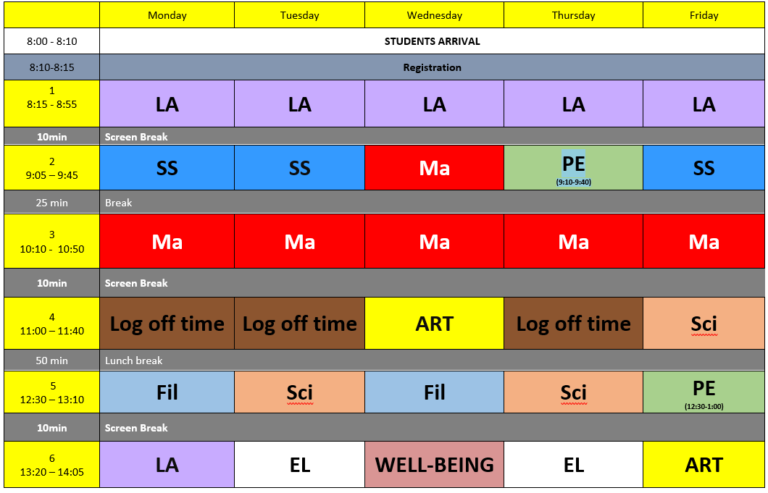Grade 1
Welcome to the Grade 1 page
On this page you can find out a little more about school life for Grade 1 at BEIS
Our Teachers

Ms Nikkie Barias
Grade 1 Teacher

Ms Jossa Sacapano
Teacher's Assistant
Curriculum Overview
Language Arts
Reading
- Know the basic features of print
- Read sight words
- Use different strategies in decoding words (such as blending sounds, grade-level phonics)
- Use context to confirm or self-correct
- Read grade-level literature and informational texts orally with purpose and understanding
- Read grade-level text fluently and accurately
Writing
- Write grade-level narratives, informative texts and opinion pieces, using the writing process
- Confer with teacher and peers to improve writing
- Participate in shared research and writing projects
Speaking and Listening
- Participate in collaborative conversations
- Ask relevant questions
- Answer questions using knowledge acquired and information presented
- Present ideas and works confidently
Grammar
- Print all upper and lowercase letters
- Apply spaces in between words
- Identify common and proper nouns
- Match nouns with appropriate verbs
- Produce complete sentences
- Demonstrate knowledge of writing conventions: capitalization and punctuation
- Spell grade-level sight words
Social Studies
Geography
- Differentiate maps from globes
- Name and locate the all continents and oceans
- Demonstrate understanding of the cardinal directions
- Read simple maps
Ancient Civilizations: Mesopotamia
- Understand how civilization started in Mesopotamia
- Demonstrate knowledge of the different rulers, important structures and practices
- Make models
Ancient Civilization: Ancient Egypt
- Understand how civilization started in Ancient Egypt
- Use hieroglyphics
- Make their own models of mummies and sarcophagus, pyramids and sphinx
- Demonstrate knowledge of the different rulers, important structures and practices in Ancient Egypt
- Understand the three world religions.
Economics: Markets
- Understand the terms: needs, wants, goods, services, producers, consumers.
- Identify and count money.
Physical Education
- Hop, gallop, jog and slide using a mature pattern.
- Demonstrate twisting, curling, bending and stretching actions.
- Dribble continuously in self-space using the preferred hand.
- Tap or dribble a ball using the inside of the foot while walking in general space.
- Travel in general space with different speeds.
- Differentiate between fast and slow speeds.
- Differentiate between strong and light force.
- Engage actively in physical education class.
- Follow teacher directions for safe participation and proper use of equipment without teacher reminders.
- Work independently with others in a variety of class environments (small and large groups).
Art
- Name the different art tools and how they are used
- Use a range of art materials
- Know the primary colors and the mixtures to make secondary colors
- Identify different lines and use them on their artworks
- Create drawings, paintings, crafts and structures
- Name artists and apply their style of art
Science
Introduction to Science
- Identify the five senses
- Understand the scientific method and the design process
Life Science
- Differentiate living things from non-living things
- Identify the needs of animals and plants
- Sort animals and plants according to different classifications
- Identify the parts of a plant and their functions
- Identify different environments
- Understand food chains
Earth and Space Science
- Differentiate natural from man-made resources
- Observe properties of rocks and soils
- Identify ways to take care of the environment
- Understand weather and seasons
- Know the movement of the sun and phases of the moon
Physical Science
- Identify the forms and properties of matter: solid, liquid and gas
- Demonstrate understanding of sound and motion
Mathematics
Numbers & Operations
- Count, read and write numbers to 120
- Understand the place values: tens and ones
- Make groups of ten
- Compare two-digit numbers using symbols
- Add within 100 (adding a two-digit number and a one-digit number, adding a two-digit number and a multiple of 10)
- Subtract multiples of 10
Measure & Data
- Order three objects by length
- Measure objects using non-standard units of measurement
- Tell and write time in hours and half-hours using analogue and digital clocks
- Organize, represent and interpret data
- Ask and answer questions about the data presented
Geometry
- Identify and distinguish two-dimensional shapes and three-dimensional shapes using various attributes
- Build and draw two-dimensional and three-dimensional shapes
- Use two-dimensional and three-dimensional shapes to create composted shapes
Fractions
- Demonstrate understanding of equal and unequal parts
- Partition shapes into halves, thirds and quarters
- Shade fractions of a shape
ICT
Digital Painting
- Create their own designs and layout using online programs
- Crop pictures using paint program
- Rotate, copy and paste image
- Use drawing tools, autofill, color picker
- Introduce 3D painting
- Use ICT to work with text and images to help them share their ideas
Web Browsing
- Explain the concept of web browsing
- Introduce various types of search engines
- Discuss the importance of internet
- Research using Internet Explorer, Google Chrome and Mozilla Firefox
- Explore information from various sources
Filipino
- Count, read and write numbers to 20 in Filipino
- Name and identify major body parts in Filipino
- Name and identify 9 different colors in Filipino
- Name 6 basic shapes in Filipino
- Identify farm, house, and jungle animals in Filipino
- Name family members
- Demonstrate knowledge of simple verbs in Filipino
- Name parts of a house in Filipino
- Use proper “pantukoy” in a sentence (si, sila, ang, ang mga
- in Filipino
- Introduce themselves in Filipino
- Identify common fruits found in the Philippines
- Identify emotions in Filipino
- Use Filipino descriptive words in a sentence
- Identify and name traditional the clothes of the Philippines

